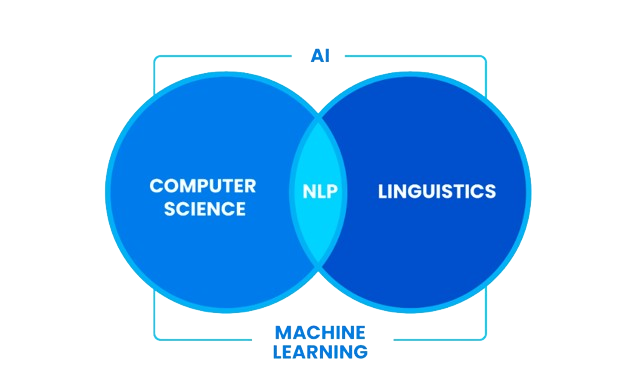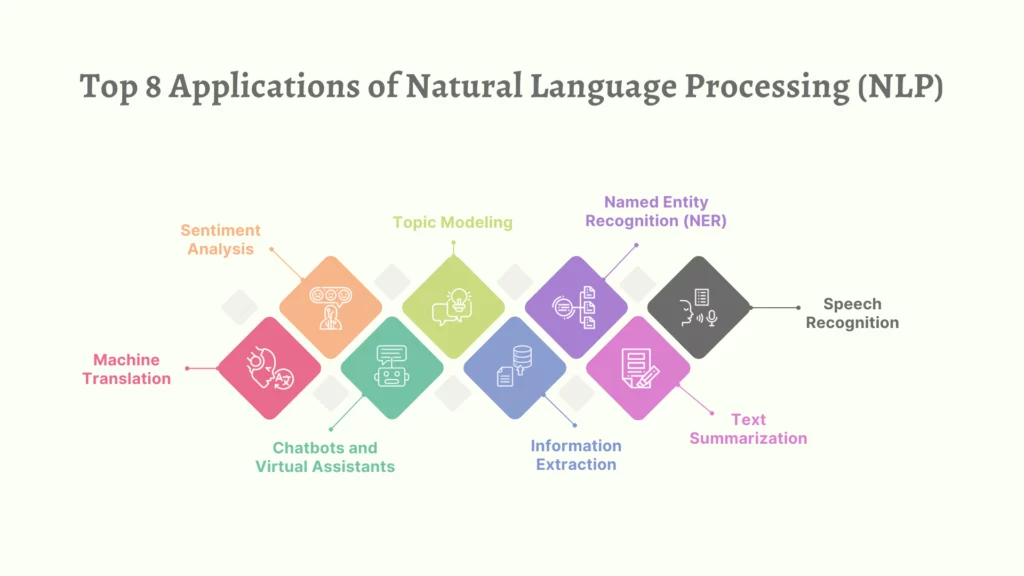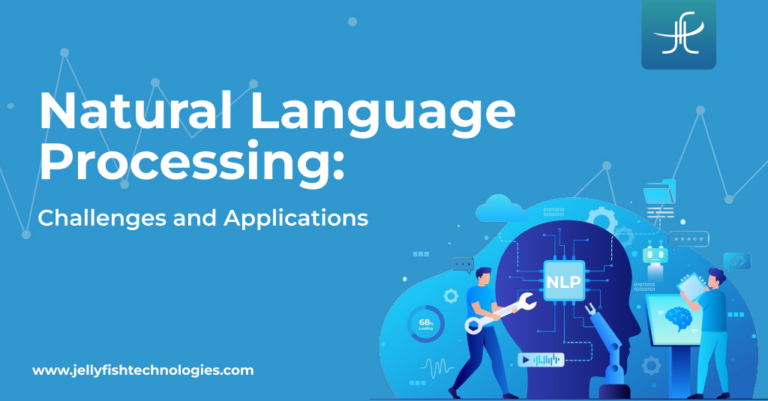Have you ever wondered how computer programs understand human language?
Well, it’s all thanks to Natural Language Processing (NLP). NLP, a branch of Artificial Intelligence (AI), intelligently understands and derives meaning from human language. It aids developers in organizing and structuring data to perform tasks, such as automatic summarization, translation, named entity recognition, relationship extraction, sentiment analysis, speech recognition, and topic segmentation.
According to Statista, the market size in the Natural Language Processing market is projected to reach US$29.19bn in 2024 and is expected to show an annual growth rate (CAGR 2024-2030) of 13.79%, resulting in a market volume of US$63.37bn by 2030.
If you’re interested in learning more about NLP, you’ve come to the right place. In this blog, we’ll explore how NLP works, its benefits, the challenges NLP faces, and its real-world applications.
Let’s dive in!
What is Natural Language Processing (NLP)?
Natural Language Processing (NLP) is a fascinating field that sits at the crossroads of linguistics, computer science, and artificial intelligence (AI). At its core, NLP is concerned with enabling computers to understand, interpret, and generate human language in a way that is both smart and useful.

In simpler terms, NLP allows computers to “read” and “understand” text or speech, much like humans do. It equips machines with the ability to process large amounts of natural language data, extract relevant information, and perform tasks ranging from language translation to sentiment analysis.
How Does Natural Language Processing (NLP) Work?
NLP systems rely on a combination of linguistic rules, statistical models, and machine learning algorithms to process and understand human language.
Here’s a simplified overview of how NLP works.
Text Preprocessing
Before any analysis can take place, raw text data is preprocessed to remove noise, tokenize sentences into words, and convert them into a format suitable for analysis.
Feature Extraction
NLP models extract features from the preprocessed text, such as word frequencies, syntactic patterns, or semantic representations, which are then used as input for further analysis.
Machine Learning
Many NLP tasks involve training machine learning models on labeled datasets to learn patterns and relationships in the data. These models are then used to make predictions or perform tasks such as classification, translation, or summarization.
Evaluation and Optimization
NLP systems are continuously evaluated and optimized to improve their performance. This may involve fine-tuning model parameters, incorporating new data, or developing more sophisticated algorithms.
TOP 10 Challenges in Natural Language Processing (NLP)
Natural Language Processing (NLP) has witnessed remarkable advancements in recent years, but it still faces several challenges that hinder its full potential.
Let’s delve into the top 10 challenges in NLP.
Ambiguity and Polysemy
One of the fundamental challenges in NLP is dealing with the ambiguity and polysemy inherent in natural language. Words often have multiple meanings depending on context, making it challenging for NLP systems to accurately interpret and understand text.
Data Sparsity and Quality
NLP models require large amounts of annotated data for training, but obtaining high-quality labeled data can be challenging. Furthermore, data sparsity and inconsistency pose significant hurdles in building robust NLP systems, leading to suboptimal performance in real-world applications.
Context and Understanding
Understanding context is crucial for NLP tasks such as sentiment analysis, summarization, and language translation. However, capturing and representing context accurately remains a challenging task, especially in complex linguistic environments.
Multilingualism and Language Variations
NLP systems must be able to handle multiple languages and dialects to cater to diverse user populations. However, language variations, slang, and dialectical differences pose challenges in developing universal NLP solutions that work effectively across different linguistic contexts.
Jellyfish Technologies Revolutionized Payleadr’s Payment System, Enhancing Security, Streamlining Operations, And Driving Business Growth With Tailored Solutions
Lack of Domain-Specific Data
Many Natural Language Processing applications require domain-specific knowledge and terminology, but obtaining labeled data for specialized domains can be difficult. This lack of domain-specific data limits the performance of NLP systems in specialized domains such as healthcare, legal, and finance.
Semantic Understanding and Reasoning
NLP systems often struggle with semantic understanding and reasoning, especially in tasks that require inferencing or commonsense reasoning. Capturing the subtle nuances of human language and making accurate logical deductions remain significant challenges in NLP research.
Handling Noise and Uncertainty
Natural language data is often noisy and ambiguous, containing errors, misspellings, and grammatical inconsistencies. NLP systems must be robust enough to handle such noise and uncertainty while maintaining accuracy and reliability in their outputs.
Ethical and Bias Concerns
NLP models can inadvertently perpetuate biases present in the training data, leading to unfair or discriminatory outcomes. Addressing ethical concerns and mitigating biases in NLP systems is crucial to ensuring fairness and equity in their applications.
Scalability and Performance
Scalability is a critical challenge in NLP, particularly with the increasing complexity and size of language models. Building scalable NLP solutions that can handle large datasets and complex computations while maintaining high performance remains a daunting task.
Interdisciplinary Collaboration
NLP research requires collaboration across multiple disciplines, including linguistics, computer science, cognitive psychology, and domain-specific expertise. Bridging the gap between these disciplines and fostering interdisciplinary collaboration is essential for advancing the field of NLP and addressing NLP challenges effectively.
| Challenges in NLP | Solutions |
|---|---|
| Ambiguity and Polysemy | Contextual embeddings capture contextual meaning |
| Data Sparsity and Quality | Semi-supervised learning leverages unlabeled data |
| Context and Understanding | Advanced language models reason about context |
| Multilingualism and Variations | Multilingual NLP research addresses language variations |
| Lack of Domain-Specific Data | Domain adaptation adapts models to specific domains |
| Semantic Understanding | Hybrid approaches combine symbolic reasoning with statistical learning |
| Noise and Uncertainty | Robust preprocessing filters out noise |
| Ethical and Bias Concerns | Fairness-aware training mitigates biases |
| Scalability and Performance | Distributed computing scales NLP systems |
| Interdisciplinary Collaboration | Collaboration fosters innovation |
Solutions to Challenges in Natural Language Processing (NLP)
While Natural Language Processing (NLP) faces several challenges, researchers and practitioners have devised innovative solutions to overcome these hurdles.
Let’s explore some key strategies for addressing the top 10 challenges of NLP.
Ambiguity and Polysemy
- Utilize contextual embeddings and deep learning techniques to capture the contextual meaning of words
- Incorporate knowledge graphs and semantic ontologies to disambiguate ambiguous terms based on their relationships with other concepts
Data Sparsity and Quality
- Implement semi-supervised and transfer learning approaches to leverage unlabeled data and pre-trained models
- Employ data augmentation techniques to generate synthetic data and improve dataset diversity
- Collaborate with domain experts to curate high-quality labeled datasets tailored to specific applications
Context and Understanding
- Develop sophisticated language models that can capture and reason about context at multiple levels of abstraction
- Explore dynamic context-aware models that adaptively adjust their representations based on contextual cues
Multilingualism and Language Variations
- Invest in multilingual NLP research to develop models that can handle diverse languages and dialects effectively
- Incorporate cross-lingual transfer learning techniques to transfer knowledge from resource-rich languages to resource-poor languages
- Collaborate with linguists and language experts to address linguistic variations and cultural nuances in different languages
Lack of Domain-Specific Data
- Explore domain adaptation and fine-tuning techniques to transfer knowledge from general domains to specialized domains
- Foster collaborations with industry partners and domain experts to collect and annotate domain-specific datasets
- Investigate unsupervised and weakly supervised learning methods to leverage unannotated or partially labeled domain-specific data
Semantic Understanding and Reasoning
- Develop hybrid approaches that combine symbolic reasoning with statistical learning for a more robust semantic understanding
- Explore commonsense knowledge bases and reasoning engines to incorporate background knowledge into NLP models
- Investigate neural-symbolic methods that integrate neural networks with symbolic reasoning engines for enhanced semantic reasoning
Handling Noise and Uncertainty
- Develop robust preprocessing techniques to filter out noise and handle data inconsistencies
- Investigate uncertainty-aware models that can quantify and propagate uncertainty through the entire NLP pipeline
- Utilize ensemble methods and model ensembling techniques to improve robustness and reliability in the face of noisy input data
Also read: Artificial Intelligence versus Machine Learning: What is the Difference?
Ethical and Bias Concerns
- Implement fairness-aware training procedures and bias mitigation techniques to identify and mitigate biases in NLP models
- Foster diversity and inclusivity in dataset collection and annotation processes to reduce bias propagation
- Promote transparency and accountability in NLP research by openly documenting biases and limitations in model performance
Are you seeking to harness cutting-edge technologies to create innovative products and applications?
Scalability and Performance
- Invest in distributed computing infrastructure and parallel processing techniques to scale NLP systems to large datasets
- Explore model compression and quantization methods to reduce the computational overhead of deploying large-scale NLP models
- Develop efficient algorithms and data structures optimized for specific NLP tasks to improve performance and resource utilization
Interdisciplinary Collaboration
- Foster interdisciplinary collaboration between researchers, practitioners, and stakeholders from diverse fields, such as linguistics, computer science, psychology, and domain-specific expertise
- Establish collaborative research initiatives and funding opportunities to facilitate knowledge exchange and interdisciplinary research in NLP
- Promote open-source development and community-driven initiatives to encourage collaboration and knowledge sharing across different disciplines
Top 8 Natural Language Processing Applications (NLP)
Natural Language Processing (NLP) has revolutionized various industries and domains, offering a wide range of applications that leverage the power of language understanding and processing.
Let’s explore some of the key Natural Language Processing applications.

Sentiment Analysis
NLP systems analyze text data to determine the sentiment or emotion expressed within it. This is widely used in market research, social media monitoring, and customer feedback analysis to gauge public opinion and sentiment toward products, services, or brands.
Machine Translation
NLP enables automatic translation of text from one language to another. NLP systems like Google Translate and Microsoft Translator utilize advanced algorithms to accurately translate text, making cross-lingual communication seamless and efficient.
Chatbots and Virtual Assistants
NLP powers conversational interfaces, such as chatbots and virtual assistants, enabling human-like interactions between users and machines. These NLP-driven systems can understand user queries, provide relevant information, and perform tasks, such as scheduling appointments, ordering food, or booking tickets.
Information Extraction
NLP techniques are used to extract structured information from unstructured text data. This includes identifying entities, such as names, dates, and locations and relationships between them, facilitating tasks like document summarization, entity recognition, and knowledge graph construction.
Text Summarization
NLP systems generate concise summaries of lengthy documents or articles, helping users quickly grasp the main points without having to read the entire text. This is valuable in scenarios where time is limited or when dealing with large volumes of textual data, such as news articles, research papers, or legal documents.
Speech Recognition
NLP enables machines to transcribe and understand human speech. Speech recognition systems like Siri, Google Assistant, and Amazon Alexa utilize NLP algorithms to convert spoken words into text, enabling hands-free interaction and voice-controlled commands.
Read more about this Natural Language Processing application in detail in our latest blog: How Voice Recognition Technology Works and Its Top Uses.
Named Entity Recognition (NER)
NLP systems identify and classify named entities mentioned in text data, such as people, organizations, locations, dates, and numerical expressions. NER is used in various applications, including information retrieval, entity linking, and event extraction.
Topic Modeling
NLP techniques cluster and categorize text documents based on their underlying themes or topics. Topic modeling algorithms like Latent Dirichlet Allocation (LDA) and Non-negative Matrix Factorization (NMF) help uncover hidden patterns and structures within large collections of text data, aiding in document classification, content recommendation, and trend analysis.

Unlock the Power of Natural Language Processing (NLP) with Jellyfish Technologies
At Jellyfish Technologies, we recognize the immense potential of NLP and are committed to providing cutting-edge solutions that harness the power of language processing. Our Natural Language Processing services encompass a wide range of applications, including sentiment analysis, machine translation, chatbots, information extraction, and more. With our expertise in machine learning, NLP technologies, and AI development services, we empower businesses to unlock new possibilities, streamline operations, and deliver exceptional experiences to their customers.
Whether you’re looking to extract insights from unstructured data, automate repetitive tasks, or enhance communication with your audience, Jellyfish Technologies is here to help. Partner with us to leverage the full capabilities of NLP and embark on a journey of innovation and growth in the digital age.


